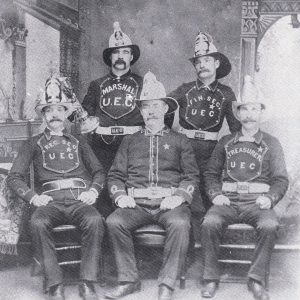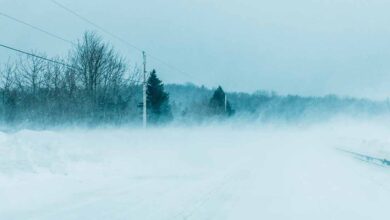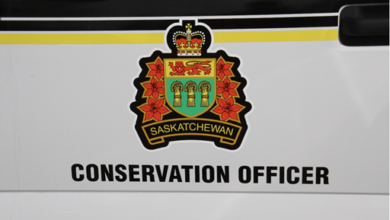
Pre 1600 — Little is known of the lives of Canada’s first peoples prior to the arrival of Samuel de Champlain in the early 1600s.
The Wendat people of Huronia lived in longhouse villages surrounded by palisades with watch towers. In times of war these towers held a supply of stones, to throw at the enemy, and water, to suppress fires that might occur.
Ladders were used to reach these galleries. Long houses were located 9–12 feet apart and often had a narrow end facing into the prevailing wind. By using these techniques in the construction of their villages the risk of fires spreading was reduced.
The 1600s
During Canada’s early settlement, buildings were generally constructed of wood. Lumber was the most prominent building material available to those who cleared the heavily forested areas. Many towns were based on the European tradition of a compact entity to protect themselves from enemies and the convenience of close commercial and social spheres. This led to many fires recorded in Canada’s early settled history.
1629 – The first recorded fire of note in Canada was when the British agents set fire to Quebec City. Champlain ordered the tolling of the tower bell to call citizens and soldiers out with buckets, axes and bars to suppress the fire.
The 1700s
Slowly settlers improved town planning and the quality of their buildings, but the temptation to rebuild makeshift structures of wood for basic shelter won out. The alarm of fire was announced by the ringing of the church bell, or a night watchman equipped with a large rattle who called out the warning through the village. The night watches responsibilities also included establishing control at the scene, prevention of looting and organizing the residents into bucket brigades to suppress the fire.
1754 on – The first organized fire department in Canada was created in Halifax, Nova Scotia, originally named the Union Fire Club. The next companies to become established in the Maritimes in the 1780s, were conceived as a mutual insurance and protection organization, which followed the governor’s requested rules and regulations.
1763 on – A Club de Feu (Fire Club) was organized in Montreal to salvage goods from burning buildings. It is thought Montreal was the first Canadian city to acquire a fire engine in 1765.
Early 1800s
The town of York, (now Toronto) created a bucket regulation stating that homeowners must have 2 two-gallon buckets made of canvas, leather or wood, painted with the owner’s name, as well as two ladders. One ladder went to the eaves of the building and the other up the roof to the chimney. By this time Montreal had five fire engines.
1824 – Following the fire which destroyed the Parliament Buildings, the Upper Canada Gazette was critical of the lack of organized firefighting. Two years later an act was put into place to form a volunteer fire company. The incentive came as an exemption to serve on juries, join the militia or perform other parish duties.
Mid 1800s – Volunteer fire companies continued to grow throughout this period. They became politically influential and there were many rivalries. They lost some influence with the arrival of steam fire engines and hydrant water systems, which required fewer men to work at the fire scene. At this time, volunteer firefighters had to provide their own leather helmets and jackets for protection from falling debris.
To gain more control, large municipalities began phasing out volunteer positions in favour of paid positions. Machinery, horses and equipment required constant maintenance which was best performed by full-time staff. Smaller communities that could not afford paid professionals continued to rely on volunteers.
In 1845, The Hudson’s Bay Company appears to have purchased the first fire engines for the Canadian Prairies to provide fire protection to its trading posts.
The first was capable of discharging from 80-100 gallons of water per minute. As the Canadian Pacific Railway pushed across the land, towns began appearing along with their own volunteer fire brigades.
Late 1800s – Canadian cities were growing larger with fairly sophisticated fire protection, such as steam fire engines, horse-drawn apparatus, hydrant systems and professional fire departments. Building codes were adopted to subdivide large storehouses with firewalls, create fire resistance between floors and provide minimum space between structures.
In the early 1900s
Rubber-lined duck coats and rubber boots became universal and were considered more practical for firefighting in Canadian climates. The colour of the gear slowly changed from the all black coats to something more visible.
With the invention of the internal combustion engine in the late 19th century, horse-drawn steam engines were eventually replaced; first with self-propelled steam-powered units, later with gasoline powered trucks.
Scientific researchers began looking into the hazardous atmospheres firefighters are exposed to when fighting fires. Because a multitude of new chemicals and plastics were continually being introduced to the construction industry, increasingly dangerous emissions were being produced when these materials burned.
Breathing apparatus was first introduced as a means for getting oxygen to firefighters entering a burning building. Early devices required hand pumping by firefighters stationed outside. But as awareness of poisonous toxins became more widespread so did improved automated and self-contained breathing apparatus’.








































